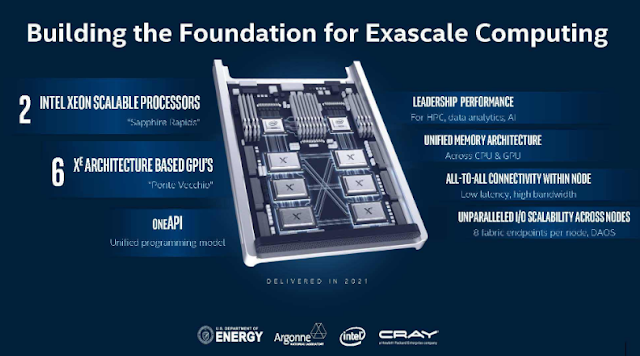Intel unveiled its new general-purpose "Ponte Vecchio" GPU architecture for HPC/AI acceleration, along with its new oneAPI, a unified and scalable programming model for the era of HPC/AI convergence.
 The oneAPI industry initiative ains to deliver a unified and simplified programming model for application development across heterogenous processing architectures, including CPUs, GPUs, FPGAs and other accelerators. The oneAPI specification includes a direct programming language, powerful APIs and a low-level hardware interface. Intel’s oneAPI beta software provides developer tools that include compilers, libraries and analyzers, packaged into domain-focused toolkits. The initial oneAPI beta release targets Intel Xeon Scalable processors, Intel Core processors with integrated graphics, and Intel FPGAs, with additional hardware support to follow in future releases. Developers can download the oneAPI tools, test drive them in the Intel oneAPI DevCloud, and learn more about oneAPI at software.intel.com/oneAPI.
The oneAPI industry initiative ains to deliver a unified and simplified programming model for application development across heterogenous processing architectures, including CPUs, GPUs, FPGAs and other accelerators. The oneAPI specification includes a direct programming language, powerful APIs and a low-level hardware interface. Intel’s oneAPI beta software provides developer tools that include compilers, libraries and analyzers, packaged into domain-focused toolkits. The initial oneAPI beta release targets Intel Xeon Scalable processors, Intel Core processors with integrated graphics, and Intel FPGAs, with additional hardware support to follow in future releases. Developers can download the oneAPI tools, test drive them in the Intel oneAPI DevCloud, and learn more about oneAPI at software.intel.com/oneAPI.
The new general-purpose GPUs are based on Intel’s Xe architecture. Ponte Vecchio will be manufactured on Intel’s 7nm technology and will be Intel’s first Xe-based GPU optimized for HPC and AI workloads. Ponte Vecchio will leverage Intel’s Foveros 3D and EMIB packaging innovations and feature multiple technologies in-package, including high-bandwidth memory, Compute Express Link interconnect and other intellectual property.
Intel said these announcements, which are being made at this week's Supercomputing 2019 in Denver, represent a paradigm shift from today’s single-architecture, single-vendor programming models.

“HPC and AI workloads demand diverse architectures, ranging from CPUs, general-purpose GPUs
and FPGAs, to more specialized deep-learning NNPs, which Intel demonstrated earlier this month,” said Raja Koduri, senior vice president, chief architect, and general manager of architecture, graphics and software at Intel. “Simplifying our customers’ ability to harness the power of diverse computing environments is paramount, and Intel is committed to taking a software-first approach that delivers a unified and scalable abstraction for heterogeneous architectures.”
https://newsroom.intel.com/news-releases/intel-unveils-new-gpu-architecture-optimized-for-hpc-ai-oneapi/#gs.gqf475
 The oneAPI industry initiative ains to deliver a unified and simplified programming model for application development across heterogenous processing architectures, including CPUs, GPUs, FPGAs and other accelerators. The oneAPI specification includes a direct programming language, powerful APIs and a low-level hardware interface. Intel’s oneAPI beta software provides developer tools that include compilers, libraries and analyzers, packaged into domain-focused toolkits. The initial oneAPI beta release targets Intel Xeon Scalable processors, Intel Core processors with integrated graphics, and Intel FPGAs, with additional hardware support to follow in future releases. Developers can download the oneAPI tools, test drive them in the Intel oneAPI DevCloud, and learn more about oneAPI at software.intel.com/oneAPI.
The oneAPI industry initiative ains to deliver a unified and simplified programming model for application development across heterogenous processing architectures, including CPUs, GPUs, FPGAs and other accelerators. The oneAPI specification includes a direct programming language, powerful APIs and a low-level hardware interface. Intel’s oneAPI beta software provides developer tools that include compilers, libraries and analyzers, packaged into domain-focused toolkits. The initial oneAPI beta release targets Intel Xeon Scalable processors, Intel Core processors with integrated graphics, and Intel FPGAs, with additional hardware support to follow in future releases. Developers can download the oneAPI tools, test drive them in the Intel oneAPI DevCloud, and learn more about oneAPI at software.intel.com/oneAPI.The new general-purpose GPUs are based on Intel’s Xe architecture. Ponte Vecchio will be manufactured on Intel’s 7nm technology and will be Intel’s first Xe-based GPU optimized for HPC and AI workloads. Ponte Vecchio will leverage Intel’s Foveros 3D and EMIB packaging innovations and feature multiple technologies in-package, including high-bandwidth memory, Compute Express Link interconnect and other intellectual property.
Intel said these announcements, which are being made at this week's Supercomputing 2019 in Denver, represent a paradigm shift from today’s single-architecture, single-vendor programming models.

“HPC and AI workloads demand diverse architectures, ranging from CPUs, general-purpose GPUs
and FPGAs, to more specialized deep-learning NNPs, which Intel demonstrated earlier this month,” said Raja Koduri, senior vice president, chief architect, and general manager of architecture, graphics and software at Intel. “Simplifying our customers’ ability to harness the power of diverse computing environments is paramount, and Intel is committed to taking a software-first approach that delivers a unified and scalable abstraction for heterogeneous architectures.”
https://newsroom.intel.com/news-releases/intel-unveils-new-gpu-architecture-optimized-for-hpc-ai-oneapi/#gs.gqf475















